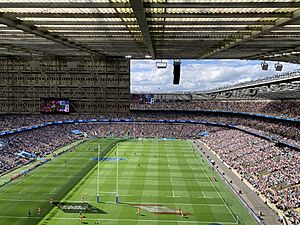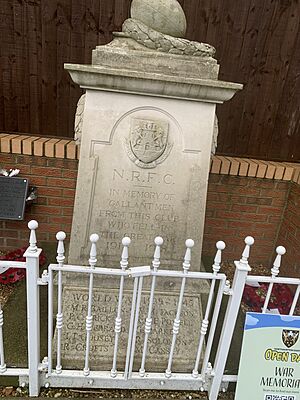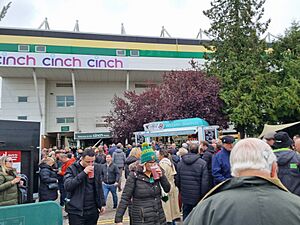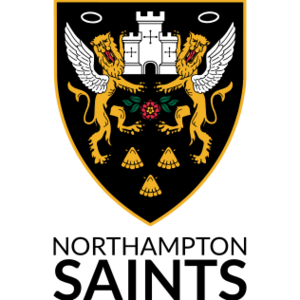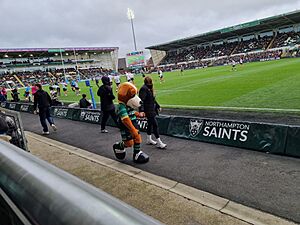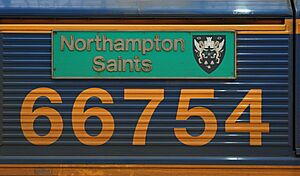Northampton Saints facts for kids
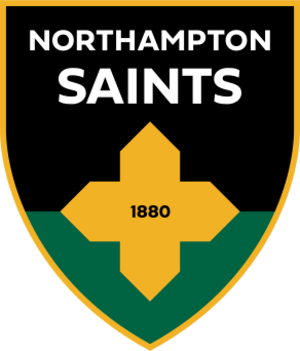 |
|||
| Full name | Northampton Rugby Football Club | ||
|---|---|---|---|
| Union | East Midlands RFU | ||
| Nickname(s) | Saints, Jimmies | ||
| Founded | 1880 | ||
| Location | Northampton, England | ||
| Region | Northamptonshire | ||
| Ground(s) | cinch stadium at Franklin's Gardens (Capacity: 15,249) | ||
| Chairman | John White | ||
| CEO | Julia Chapman | ||
| Director of Rugby | Phil Dowson | ||
| Captain(s) | George Furbank | ||
| Most appearances | Ron Jacobs (470) | ||
| Top scorer | Paul Grayson (2,786) | ||
| Most tries | Teddy Cook (219) | ||
| League(s) | Premiership Rugby | ||
| 2024–25 | 8th | ||
|
|||
| Official website | |||
The Northampton Saints (officially called Northampton Rugby Football Club) is a professional rugby union team. They are based in Northampton, England. The club plays in Premiership Rugby, which is England's top rugby league.
The club started in 1880 as "Northampton St. James". This is how they got their famous nickname, Saints. The team plays its home games at Franklin's Gardens, which can hold 15,249 fans. This stadium is in the St James area of town. Since the early 1900s, the team has worn black, green, and gold colors.
At the end of the 2024–25 Premiership Rugby season, the Saints finished 8th. This means they can play in the 2025–26 European Rugby Champions Cup. The current director of rugby is Phil Dowson. He took on this role in the summer of 2022.
The Saints have won seven major titles so far. They were European Champions in 2000. They also became English Champions in 2014 and 2024. The team has won the European Rugby Challenge Cup twice, in 2009 and 2014. They also won the Anglo-Welsh Cup in 2010. In 2019, they won the first-ever Premiership Rugby Cup.
The Saints have also won the Second Division title three times. These wins were in 1990, 1996, and 2008. The Saints' biggest rivals are the Leicester Tigers. Their matches are known as the East Midlands Derby. It is one of the most intense rivalries in English rugby.
Contents
- Club History and Development
- The Saints' Home: Franklin's Gardens
- Team Kits
- Club Culture and Identity
- Club Partnerships
- Club Achievements
- Current Team Squad
- Club Staff
- Famous Former Players
- Team Statistics
- See also
Club History and Development
How the Saints Began (1880-1945)
The club started in 1880. It was first called Northampton St. James. A local church leader, Rev Samuel Wathen Wigg, created the club. He wanted to help young boys in his area. This is how the club got its nicknames, "The Saints" and "Jimmies".
The first official game was against a local team called the Star. In the early days, Saints played against other Northampton teams. They also played against the Northampton Unity Football Club. The Saints quickly became one of the top rugby teams in England. By 1897, they were very strong. In 1900, Harry Weston became the first Saints player to play for the England national team. Big crowds of about 10,000 people came to watch important games.
Team Name and Other Clubs
In 1897, the Saints wanted to change their name to "Northampton Football Club". However, the new association football club, Northampton Town FC, also wanted this name. After some talks, Northampton Town FC let the Saints keep the name.
The Saints also formed a good relationship with Northampton Cricket Club. They even gave money from their games to help the cricket club.
Playing the Original All Blacks
In 1905, the Saints played against the famous Original All Blacks team. The Saints lost the game 32–0. To remember this special match, a gold stripe was added to the Saints' black and green shirts. This design has been used ever since.
The Story of Edgar Mobbs
In 1908, Edgar Mobbs joined the Saints. He was a hero in Northampton and Bedford. He was the first Northampton player to be captain for England. Edgar Mobbs is best known for his bravery in World War I. He was told he was too old to join the army. So, he created his own group of soldiers called Mobbs Own. He died in 1917 while leading his group into battle. His body was never found. A monument was built for him in Northampton's Market Square.
The club started the Mobbs Memorial Match in 1921 to honor him. This game was played every year. Now, it is played between Bedford Blues and Northampton as a preseason game.
Growing Stronger After the Wars
After World War II, the Saints continued to grow. They produced some of England's best players. Many of these players became captains for their country. The club was a major force in English rugby for many years.
The 1988 Changes
By 1988, the club was falling behind. Top players were not joining the team. Some former players decided to make big changes. This was called the 'Saints Revolution'. They wanted to bring the club back to the top of English rugby.
Back to Normal
With Barrie Corless as director of rugby, the club started to rebuild. The Saints began to improve quickly. They even signed All Blacks legend Buck Shelford.
In 1990, Northampton Rugby Union Football Club moved up to the First Division. The next year, they played in their first Pilkington Cup Final at Twickenham. They lost in extra time, but the team was getting stronger. Players like Tim Rodber, Ian Hunter, Paul Grayson, Matt Dawson, and Nick Beal joined the England team.
In 1994, Ian McGeechan became the director of rugby. The club was relegated in his first season. But they came back strong the next year. They won every match and scored many points. Fans called this season the "Demolition Tour of Division Two".
The Professional Era
In 1995, rugby union became a professional sport. A local businessman, Keith Barwell, took over the club.
In 1999, the Saints finished second in the Allied Dunbar Premiership. Ian McGeechan left, and former Saints player John Steele took over. Steele, along with captain Pat Lam, led the club to European success.
In the 1999–2000 season, the club became a public company. The Saints lost in the Tetley's Bitter Cup Final. But they won their first major trophy by beating Munster 9–8 in the European Cup Final.
After a tough start in 2001–2002, Wayne Smith became head coach. He quickly improved the team. They reached the Powergen Cup final and qualified for the Heineken Cup. Travis Perkins became the club's main sponsor in 2001.
The club almost got relegated in 2004–05. Coaches Budge Pountney and Paul Grayson took over. In the 2006–07 Heineken Cup, Northampton reached the semi-finals. They beat French champions Biarritz 7–6.
Relegation and Return (2007–2014)
On April 28, 2007, Northampton was relegated from the English Premiership. Jim Mallinder became the new head coach and director of rugby. His assistant was Dorian West.
On March 22, 2008, Northampton beat Exeter Chiefs to get promoted back to the Guinness Premiership. On April 12, 2008, they won the EDF Energy Trophy by beating Exeter Chiefs again. They finished their National Division One season with a perfect record of 30 wins.
In the 2008–09 season, the Saints finished eighth. They also won the European Challenge Cup. They beat French team Bourgoin 15–3 in the final. This win earned them a spot in the 2009–10 Heineken Cup.
In March 2010, the Saints won the Anglo-Welsh Cup final against Gloucester 30–24. This was their fourth trophy in three years. They also finished second in the English Premiership.
Northampton finished fourth in the 2010–11 English Premiership. They also reached the final of the Heineken Cup. They were beaten by Leinster 33–22.
At the start of the 2011–12 season, many players were away for the 2011 Rugby World Cup. The Saints were knocked out of the 2011–12 Heineken Cup. When the international players returned, the Saints moved up the league table. Eight Saints players were chosen for the England team. This was a new club record. In 2011–12, the Saints reached their third Premiership semi-final in a row.
In 2012–13, the Saints won their first five matches. They finished fourth in the league. They beat Saracens in the semi-final. This sent them to their first-ever Premiership final. They lost to Leicester 37–17.
In the 2013–14 season, the club finished second in the league. They went on to win the Premiership title. They beat Saracens 24–20 in extra time. They also won the 2013–14 European Challenge Cup. They beat Bath 16–30 in the final.
Recent Seasons (2014-Present)
After their most successful season, the Saints finished first in the Rugby Premiership in 2014–15. However, they lost to Saracens in the semi-finals.
After a few difficult seasons, director of rugby Jim Mallinder left the club in December 2017. Australian coach Alan Gaffney took over temporarily. The team finished 9th that year but avoided relegation.
New Leadership and Cup Wins
In January 2018, Hurricanes coach Chris Boyd joined the Saints. In Boyd's first season, the Saints won the Premiership Rugby Cup. They beat Saracens 23–9 at home. The Saints also finished in the top 4 for the first time since 2015.
Second League Title
The 2023–24 regular season was very close. The Saints finished first, just ahead of Bath. They faced Saracens in a home semi-final and won 22–20. This was the last home game for Courtney Lawes.
The final was on June 8 against a strong Bath team. The Saints won 24–21 in a close game. This was their second league win, exactly 10 years after their first in 2014. A parade was held the next day. Thousands of fans came out to celebrate.
Third European Final
The Saints had a great run in the 2024–25 European Rugby Champions Cup. They won their knockout matches against ASM Clermont Auvergne and Castres Olympique. Then, they faced a tough Leinster team in Dublin. The Saints won 34–37 in a stunning victory. This sent them to their third European final on May 25 in Cardiff. They played against Union Bordeaux Bègles.
The Saints' Home: Franklin's Gardens
Franklin's Gardens Stadium
Northampton Saints have played at Franklin's Gardens since 1880. It is a stadium built just for rugby. It is located west of the town center. The club also has two training pitches, an indoor training center, and a club shop. The stadium can hold 15,249 fans for games and 18,000 for concerts. It also has 40 special boxes for groups. Franklin's Gardens is also a conference center. It is the only Premiership ground with its own war memorial, called a cenotaph. This memorial is in the north corner of the stadium. All parts of the stadium have wheelchair access.
The Saints had a long unbeaten home record from March 2007 to March 2009. In September 2021, Northampton Saints announced a six-year deal with cinch (company). This deal included naming rights for Franklin's Gardens. The stadium is now called cinch stadium at Franklin's Gardens.
The Carlsberg Stand
This stand used to be called the Tetley's Stand until 2018. It is the largest stand in the stadium. It runs along the eastern side of the pitch. It has both seats and a standing area. There are also 14 executive boxes above. Below the stand, there is the Rodber bar, which can hold 600 people. The Captain's Bar and Heroes Restaurant are also used for events and serve fans on match days.
cinch Stand
The cinch Stand is at the south end of the ground. It has the highest seating area. It was built at the same time as the Carlsberg Stand. Building it was tricky because of a lake behind it. In 2005, the stand was made taller, adding about 1000 seats. It was named the Burrda Sport Stand in 2010, then the Elite Insurance Stand in 2016, and finally the cinch Stand in 2022.
Church's Stand
Church's Stand is on the west side of the pitch. It was also built in 2001–2002. It has only seats and no executive boxes. Below the seats are the changing rooms for both teams. There is also a gym and kit facilities. The Tunnel Club is here, offering a special viewing area for guests. The coaches' seating area is at the top of this stand.
Barwell Stand
The Barwell Stand was built in 2015. It replaced the old Sturtridge Pavilion. It has seats, except for the executive box section at the top.
In 2009, the club wanted to make the stadium bigger. They planned to increase the capacity to 17,000. This was going to be funded by a supermarket chain. But after some issues, the club got a loan from the local council. Building started in 2015. The Barwell Stand was finished for the 2015–16 Premiership Rugby season. It brought the stadium's capacity to 15,249. The stand has a Members' bar. Its walls are decorated with pictures of every international player who has played for the club.
Stadium Village and Other Areas
The Stadium Village is behind the cinch Stand. It has bars, food stalls, a big screen, and a seating area by the lake. The Crooked Hooker bar is one of the oldest buildings at the stadium. There is also a large tent for events. The Northampton Saints' Foundation offices are in the village.
The Club Shop was once a nightclub. It is north of the stadium and sells team kits and other items. The main ticket office is behind the shop.
The Northampton Saints' High Performance Centre opened in 2023. It is an indoor training area with artificial grass. It also has changing rooms and a half-sized training pitch. There are two more outdoor training pitches for youth players and the second team.
The stadium has six car parks with space for 1,500 cars.
Past Stadiums
The club's first home was on Mill Lane from 1880 until 1894. The Saints also played some games at the County Ground in the early 1900s.
The club played a 2011 Heineken Cup quarter-final match at Stadium MK in Milton Keynes. Franklin's Gardens was too small for the European Rugby Cup rules. The Saints won that match. They also played their semi-final there. The Saints hosted one Premiership match a season at Stadium MK from 2014–15 to 2016–17. After that, they stopped playing there.
Team Kits
In 2008, the Saints changed their kit supplier from Kooga to Rhino. Then, they switched to Burrda Sport in 2010. Burrda Sport brought back the traditional ring design. In the 2014–15 season, Burrda released a popular kit with horizontal green, black, and gold stripes. In the 2016–17 season, Macron became the Saints' kit supplier.
For the 2021–2022 season, the club released a special away shirt. It had the names of season-ticket holders who donated their tickets during the coronavirus pandemic.
Kit History
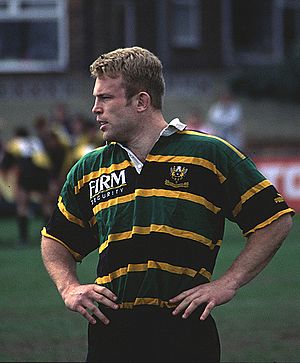
| Years | Kit Manufacturer | Main Sponsor |
|---|---|---|
| 1970s–1989 | Europa Sports | None |
| 1989–1993 | Cotton Oxford | Carlsberg |
| 1993–1995 | Puma | |
| 1995–1996 | Firm Security | |
| 1996–1998 | Cotton Traders | |
| 1998–2000 | Tetley's | |
| 2000–2001 | Canterbury | |
| 2001–2003 | Travis Perkins | |
| 2003–2007 | KooGa | |
| 2007–2010 | Rhino Rugby | |
| 2010–2015 | Burrda Sports | |
| 2015–2017 | Macron | |
| 2017–2020 | Toolstation | |
| 2020–2023 | Travis Perkins | |
| 2023–2026 | Cinch |
Current Kit Design
The current kit is made by Macron. The main sponsor, Cinch, is on the front of the shirt. GRS is on the collar. The shoe company Church's is on the left sleeve. The logo of the tournament changes on the right sleeve. Below it is the Rugby Against Racism logo. On the back, Cinch is above the player's name and number.
Special Kits
In 2001, a special home shirt was made. It had a "Champions of Europe" badge. This was to celebrate the Saints' win against Munster in the final.
In 2021, the Saints released a limited edition shirt. It marked 20 years of partnership with Travis Perkins.
Club Culture and Identity
Team Colors and Crest
Jersey Colors
The Saints first played in a red kit. Then, they changed to black and green with a simple cross. This cross was later removed. In 1904, the gold stripe was added after the Saints played the Original All Blacks. These black, green, and gold colors have been used for every home kit since.
Crest History
In the 1950s, a new crest was designed for the club. It was based on the coat of arms of Northampton. This crest was used on official documents and formal wear. It first appeared on a match shirt in 1984.
The crest had two small changes. In 1996, the text below it changed to "Northampton Rugby Football Club". In 2016, it changed again to "Northampton Saints".
A new crest was shown on July 11, 2024. It has the original 1880 cross in the middle of a shield. Some fans liked the change, while others did not.
Away and Cup Jerseys
The Saints' first away shirt came out in 1990. It was white, green, and gold. This design is still often used for away shirts. Over the years, many other designs have been used. These include mainly black kits, white shirts with stripes, sky blue, neon green, and grey. In 2018, a red shirt was worn to honor the county's colors.
The club sometimes uses special cup or third shirts. These have been yellow, black, and red.
Rivalries
The Saints' main rivals are the Leicester Tigers. Their games are called the East Midlands Derby. In recent years, the Saints have also developed a rivalry with Saracens. This is because they have played each other often, especially in big games like the 2013–14 Premiership Rugby Final. The rivalry with Saracens became less intense when Saracens were relegated. However, it has become strong again since Saracens returned to the Premiership.
Songs and Chants
Saints fans have several songs and chants. These are often sung in the standing area of the Carlsberg Stand.
Songs
The Saints' main club song is When the Saints Go Marching In. Fans sing it often and usually faster than other teams.
Another popular song is "The Fields Are Green". This song has been linked to Northampton for many years. Coach Phil Dowson introduced it to the players in 2022. Now, fans also sing it in the stands. This helps connect the team more to the town.
Chants
Fans often chant "Come on you Saints" and "Jimmies". The "Jimmies" chant is used less now. More recently, fans chant "Shoe Army". This nickname comes from the town's history of making shoes. Fans have even been seen taking off their shoes during this chant!
Player Identity
Coaches have tried to create a strong identity for the players. Wayne Smith once bought a "punishment car" for players who made mistakes. It was a small car painted in club colors. He also gave a "player of the week" shirt (a Superman shirt) to top players.
Coach Phil Dowson has encouraged players to connect with Northampton's history. Players sing songs about the town's shoemaking past. These changes help the players feel more connected to the local community.
Other Club Symbols
The Stickman
The Saints' Stickman is a club symbol used since the 1980s. He has a halo and carries a rugby ball. The Stickman comes from books by Leslie Charteris. The club sells items with the Stickman on them. A popular one is a car sticker.
Bernie the Mascot
Bernie is the club's mascot. He is a Saint Bernard dog. You can see him at home games. Bernie has been a club symbol since at least 1999. His design has stayed the same, only his shirt changes each season.
The Saints Train
In 2015, a freight train was named "Northampton Saints". This was to honor the team's Premiership title win the year before. The Saints were the first rugby team to have a train named after them.
Community Involvement
Youth Events
The Saints are very active in the local community. Players help with training sessions for young people at clubs in the county. The annual Saints' training camp takes place at Stowe School.
Supporters' Club
The Northampton Saints' Supporters' Club started in 1922. Its goal is to represent fans and help their voices be heard. The club supports local teams and helps increase attendance at games. They also organize trips for fans to away games.
Northampton Saints' Foundation
The Foundation was created in 2018. It helps young people learn about jobs, life skills, and how to get along with others. It also helps preserve the club's history. The Foundation researches and shares information about the club's past.
The Parish
The Parish is a club program that helps the local area. It gives benefits and special offers to people who live near the stadium.
Local Business Connections
Many businesses in Northampton show Saints' flags and colors. Many bars and pubs display Saints' items. In 2024, the Northampton Saints Business Club was created. It aims to build strong relationships with local businesses. This helps the local economy grow.
Club Partnerships
Bedford Blues
In 2020, the Saints announced a partnership with the Bedford Blues. Some Saints players would be able to play for the Bedford Blues. Both clubs are close and have a shared history.
This agreement means the two clubs play an annual pre-season match. They also share coaching staff.
Loughborough Lightning
In 2021, the Saints partnered with the Loughborough University Women's Rugby Team. They play in Premiership Women's Rugby, England's top women's league. This partnership means some Lightning games are played in Northampton. The Northampton Saints' badge also appears on their shirts. The team even gets a special kit in Saints colors for games played in Northampton.
Club Achievements
Northampton Saints Trophies
- European Rugby Champions Cup
- Champions: (1) 1999–00
- Runners-up: (2) 2010–11, 2024-25
- European Challenge Cup
- Champions: (2) 2008–09, 2013–14
- Premiership Rugby
- Champions: (2) 2013–14, 2023–24
- Runners-up: (2) 1998–99, 2012–13
- RFU Championship
- Champions: (3) 1989–90, 1995–96, 2007–08
- Premiership Rugby Cup
- Champions: (1) 2018–19
- Anglo-Welsh Cup
- Champions: (1) 2009–10
- Runners-up: (2) 2011–12, 2013–14
- RFU Knockout Cup
- Runners-up (4):1990–91, 1999–00, 2001–02, 2002–03
- EDF Energy Trophy
- Champions: (1) 2007–08
- Selkirk Sevens
- Champions: (2) 1991, 1993
- Middlesex Sevens
- Champions: (1) 2003
Northampton Wanderers (Reserve Team) Trophies
- Premiership Rugby Shield
- Champions: (3) 2008–09, 2016–17, 2017–18
- Runners-up: (4) 2003–04, 2007–08, 2013–14, 2015–16
Current Team Squad
The Northampton Saints squad for the 2024–25 season is:
Note: Flags indicate national union as has been defined under WR eligibility rules. Players may hold more than one non-WR nationality.
Academy Squad
Note: Flags indicate national union as has been defined under WR eligibility rules. Players may hold more than one non-WR nationality.
|
|
Club Staff
First Team Coaches
- Phil Dowson – Director of Rugby
- Lee Radford – Defence Coach
- Sam Vesty – Head/Attack Coach
- Matt Ferguson – Scrum Coach
- James Craig – Line Out Coach
Academy Staff
- Mark Hopley – Academy Manager
- Alex O'Dowd – Player and Coach Development Manager
- Jake Sharp – Academy Coach
- Will Parkin – Academy Coach
- Jim Henry – Academy Coach
- Tim Grimsey – Academy Coach
Famous Former Players
Rugby World Cup Players
These players represented their countries at the Rugby World Cup while playing for Northampton:
| Tournament | Players selected | England players | Other national team players |
|---|---|---|---|
| 1987 | 1 | Gary Pearce | |
| 1991 | 2 | Gary Pearce, John Olver | |
| 1995 | 4 | Martin Bayfield, Ian Hunter, Tim Rodber | Peter Walton |
| 1999 | 7 | Nick Beal, Matt Dawson, Paul Grayson, Tim Rodber | Budge Pountney |
| 2003 | 5 | Ben Cohen, Matt Dawson, Paul Grayson, Steve Thompson | Tom Smith |
| 2007 | 3 | Soane Tongaʻuiha |
|
| 2011 | 8 | Chris Ashton, Ben Foden, Dylan Hartley, Courtney Lawes, Tom Wood | Soane Tongaʻuiha |
| 2015 | 8 | Kieran Brookes, Courtney Lawes, Tom Wood | George North |
| 2019 | 7 | Piers Francis, Courtney Lawes, Lewis Ludlam | Ahsee Tuala |
| 2023 | 5 | Alex Mitchell, Courtney Lawes, Lewis Ludlam | Sam Matavesi, Temo Mayanavanua |
British and Irish Lions Players
These players toured with the British & Irish Lions while playing for the club:
- Blair Swannell (1899 & 1904)
- Robin Harrison (1910)
- Bill Weston (1936)
- Jeff Butterfield (1955 & 1959)
- Dickie Jeeps (1955, 1959 & 1962)
- Frank Sykes (1955)
- Keith Savage (1966 & 1968)
- David Powell (1966)
- Bob Taylor (1968)
- Peter Larter (1968)
- Bryan West (1968)
- Ian Hunter (1993)
- Martin Bayfield (1993)
- Matt Dawson (1997 & 2001)
- Tim Rodber (1997)
- Nick Beal (1997)
- Gregor Townsend (1997)
- Paul Grayson (1997)
- Ben Cohen (2001)
- Steve Thompson (2005)
- Euan Murray (2009)
- Courtney Lawes (2017 & 2021)
- George North (2017)
- Dan Biggar (2021)
Hall of Fame Members
The Northampton Saints Hall of Fame started in 2004. It honors the club's best players. So far, 21 players have been added:
|
Note: Flags indicate national union as has been defined under WR eligibility rules. Players may hold more than one non-WR nationality.
|
Team Captains
- 1880–81 F Barker
- 1882 A Timms
- 1883 T Racer
- 1884 E Eyles
- 1885–86 C Stanley
- 1887 T Stanley
- 1888 E S Dunkley
- 1889 C Stanley
- 1890 A E Orton
- 1891 C Stanley
- 1892–93 A E Orton
- 1894–95 C H Davis
- 1896 K H Kingston
- 1897 C H Davis
- 1898 K H Kingston
- 1899 H B Kingston
- 1900–01 W H Kingston
- 1902 H T F Weston
- 1903–04 H E Kingston
- 1905 R West
- 1906 E C Palmer
- 1907 J H Miles
- 1908–13 E R Mobbs
- 1914 E C Cook
- 1920–22 A G Bull
- 1923 C P Tebbitt
- 1924 A G Bull
- 1925 R Vaughan
- 1926 A F Blakiston
- 1927 R Jones
- 1928 J B Merry
- 1929–30 W H Weston
- 1931 E Coley
- 1932 T Harris
- 1933–34 W H Weston
- 1935 A D Matthews
- 1936 R J Longland
- 1937 T Harris
- 1938 W H Weston
- 1939–41 G S Sturtridge
- 1943–46 A P Bell
- 1947 R Longland
- 1948 R W Hamp
- 1949 E R Knapp
- 1950–54 D R White
- 1955 M J Berridge
- 1956–57 D R White
- 1958 R E G Jeeps
- 1959–61 C R Jacobs
- 1962–63 P J Taylor
- 1964 A R Turnell
- 1965–66 C R Jacobs
- 1967 R B Taylor
- 1968–72 D L Powell
- 1973–74 M J Roper
- 1975–76 I D Wright
- 1977 J J Page
- 1978 P Johnson
- 1979–80 P Sweet
- 1981–82 P McGuckian
- 1983 V Cannon
- 1984 J A G D Raphael
- 1985–86 D R Woodrow
- 1987 G J Poole
- 1988 G Steele-Bodger
- 1989–91 G Pearce
- 1992–93 C J Olver
- 1994–99 T A K Rodber
- 1999–2001 P R Lam
- 2001 A C Pountney
- 2002–04 A C Pountney and J Leslie
- 2004 C Krige until November then S G Thompson
- 2005 S G Thompson and T B Reihana
- 2006–09 T B Reihana
- 2009–14 D M Hartley
- 2015 L Dickson
- 2016 T Wood
- 2017–18 D M Hartley
- 2018–19 A Waller and D M Hartley
- 2019–20 A Waller and T Harrison
- 2020-21 A Waller and L Ludlam
- 2021-24 L Ludlam
- 2024 - G Furbank
Team Statistics
Overall Game Stats
- Most Points in a match: 111 (against Timișoara Saracens in 2019)
- Most Tries in a match: 17 (against Timișoara Saracens in 2019)
- Most Conversions in a match: 13 (against Sedgley Park in 2008 and Timișoara Saracens in 2019)
- Most Penalty Goals in a match: 7 (against Richmond in 1997)
- Most Drop Goals in a match: 2 (against Newcastle Falcons in 1996)
Player Records
Most Appearances
- 470 – Ron Jacobs (1949–66)
- 448 – Don White (1943–61)
- 438 – Vince Cannon (1973–89)
- 436 – Alf Chalmers (1897–1912)
- 426 – Tom Harris (1923–37)
Most Tries (Scores)
- 219 – Teddy Cook (1908–23)
- 207 – Billy Kingston (1895–1905)
- 185 – Barry Oldham (1964–78)
- 179 – Edgar Mobbs (1905–13)
- 178 – Frank Packman (1983–96)
Most Points Scored
- 2,786 – Paul Grayson (1996–2005)
- 2,655 – Stephen Myler (2006–2018)
- 1,463 – Roger Hosen (1955–67)
- 1,385 – John Steele (1988–94)
- 1,113 – Ian Moffat (1967–74)
See also
 In Spanish: Northampton Saints para niños
In Spanish: Northampton Saints para niños
- Premiership Rugby
- Heineken Cup
- Premiership Rugby Cup
- European Challenge Cup
- Franklin's Gardens



